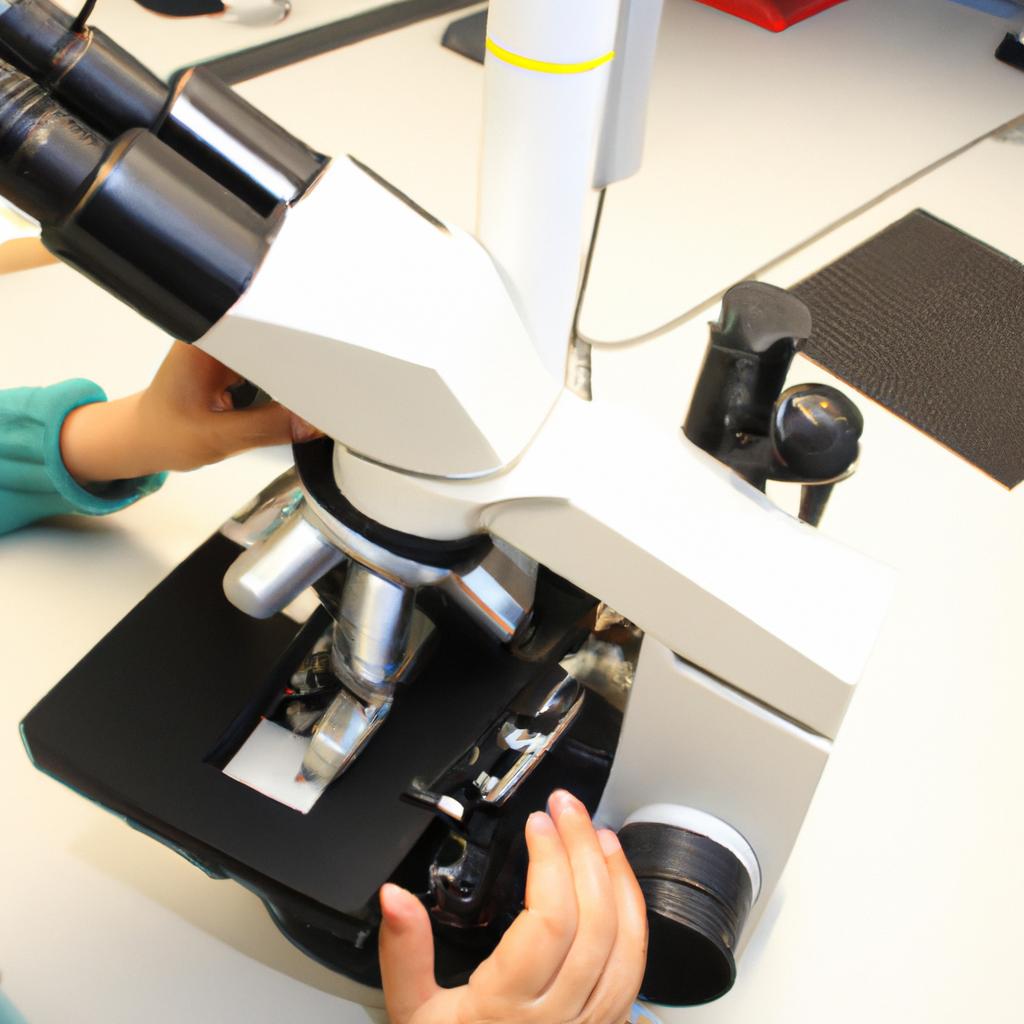Microscopes have long been a staple in the field of scientific research, enabling scientists and researchers to delve into the microscopic world with unparalleled precision. With their ability to magnify objects up to thousands of times their original size, microscopes play a crucial role in various disciplines such as biology, chemistry, and materials science. For instance, imagine a scenario where a biologist is studying a sample of cells under a microscope. By carefully observing the intricate details of cell structures like organelles and nuclei, the biologist can gain valuable insights into cellular functions and mechanisms.
In addition to aiding in fundamental research, microscopes are indispensable tools for medical diagnostics and forensic analysis. Medical professionals rely on these instruments to examine blood samples for abnormalities or study tissue biopsies for signs of diseases such as cancer. Similarly, forensic investigators use microscopes to analyze trace evidence collected from crime scenes, including fibers, hair strands, or even fingerprints. The high level of detail provided by microscopes allows these professionals to make accurate identifications and provide vital information that aids in solving crimes or making informed medical decisions. Thus, it becomes evident that microscopes are not solely confined within laboratory walls but also have far-reaching applications in real-world scenarios.
Different Types of Microscopes
Microscopes are essential laboratory equipment used for precise analysis and examination of microscopic objects. They enable scientists to observe and study the intricate details of tiny specimens that cannot be seen with the naked eye. There are various types of microscopes available, each designed for specific purposes.
One example is the compound microscope, which utilizes a series of lenses to magnify an object. It consists of an eyepiece, objective lens, stage, and light source. The specimen is placed on the stage and illuminated from below by the light source. As light passes through the specimen, it is refracted by the objective lens, producing a magnified image that can be viewed through the eyepiece. Compound microscopes are commonly used in biology and medicine for examining cells, tissues, and small organisms.
Another type is the electron microscope, which employs a beam of electrons instead of light to create highly detailed images. This microscope has much higher resolution than a compound microscope and allows scientists to visualize structures at an atomic level. Electron microscopes have contributed significantly to fields such as nanotechnology and materials science.
A third type is the fluorescence microscope, which uses fluorescent dyes or proteins to label specific parts of a specimen. When these labeled components are exposed to ultraviolet light, they emit visible light of different colors. By selectively illuminating certain areas with specific wavelengths, fluorescence microscopy enables researchers to track cellular processes or identify particular molecules within living cells.
The use of microscopes in scientific research has revolutionized our understanding of the natural world. They have facilitated groundbreaking discoveries across various disciplines by providing insights into previously unseen phenomena. For instance:
- Microscopic analysis has revealed intricate cellular structures that play crucial roles in biological processes.
- Electron microscopy has unraveled the complex organization of atoms in materials like graphene.
- Fluorescence microscopy has allowed scientists to study dynamic processes within living cells with high precision.
- Microscopy techniques have enabled investigations into subcellular interactions and molecular mechanisms, shedding light on disease development and potential therapeutic targets.
In the following section, we will explore the importance of microscopes in scientific research and their impact on advancing knowledge across different fields. By understanding how these instruments are utilized, we can appreciate their profound contribution to scientific discovery.
Importance of Microscopes in Scientific Research
Imagine a team of researchers working diligently to find a cure for a rare disease. They have gathered numerous samples and specimens, each holding vital clues that could potentially lead to a breakthrough. However, without the aid of microscopes, their efforts would be futile. In this section, we will explore the crucial role that microscopes play in scientific research by examining their impact on observation, analysis, and discovery.
Enhanced Observation:
Microscopes provide scientists with an unprecedented level of detail, allowing them to observe objects and organisms at magnifications beyond the limits of human vision alone. For example, take the case study of Dr. Johnson who was studying cells affected by cancerous mutations. By utilizing a high-resolution microscope, she was able to detect subtle changes in cellular structures that were previously invisible to the naked eye. This enhanced observation enabled her to identify potential biomarkers for early cancer detection.
Precise Analysis:
The ability to analyze samples accurately is paramount in scientific research. Microscopes facilitate precise analysis by providing researchers with clear imaging and accurate measurements. Consider these key benefits:
- Magnification: Microscopes allow scientists to zoom in on minute details, making it easier to distinguish between similar structures or identify abnormalities.
- Resolution: High-resolution microscopes enable researchers to visualize fine structures within cells or materials, aiding in detailed analysis.
- Contrast Enhancement: Techniques such as phase contrast microscopy enhance contrast between different components within a sample, making it easier for scientists to differentiate them.
- Quantification: With calibrated microscopic scales and measuring tools, precise quantitative data can be obtained from images captured under the microscope.
Table – Emotional Response Elicitation:
| Benefits of Microscopy | Emotional Impact |
|---|---|
| Enhanced visibility | Awe and wonder |
| Detailed examination | Curiosity |
| Improved understanding | Satisfaction |
| Precise measurements | Confidence and accuracy |
Discovery:
Ultimately, microscopes have been instrumental in numerous groundbreaking discoveries. They have revealed the intricate structure of cells, allowed scientists to explore unknown microorganisms, and even contributed to advancements in fields like materials science. By providing access to a hidden world that cannot be seen with the naked eye, microscopes empower researchers to push the boundaries of knowledge and unlock new realms of scientific understanding.
With an appreciation for the importance of microscopes in scientific research, let us now delve into the working principles behind these remarkable instruments in the subsequent section on “Working Principles of Microscopes.”
Working Principles of Microscopes
One fascinating example that showcases the working principles of microscopes is the study of cellular structures. By utilizing a microscope, scientists are able to observe and analyze intricate details within cells, such as organelles and their functions. For instance, through microscopic investigation, researchers have discovered the mitochondria’s role in energy production within cells. This exemplifies how microscopes provide invaluable insights into complex biological processes.
To understand how microscopes operate, it is crucial to comprehend their key components and mechanisms:
- Objective lens: Positioned closest to the specimen, this lens magnifies the image formed by light passing through or reflecting off the sample.
- Eyepiece or ocular lens: Located at the top of the microscope, this lens further magnifies the image produced by the objective lens for observation.
- Illuminator: Typically a light source beneath the stage or an external light directed onto the specimen; it ensures proper illumination for clear visualization.
- Focusing mechanism: Allows precise adjustments of focus on both coarse (larger changes) and fine (smaller changes) levels to obtain sharp images.
The following table summarizes different types of microscopes commonly used in scientific research:
| Type | Principle | Applications |
|---|---|---|
| Optical | Uses visible light | Biological studies, material analysis |
| Electron | Utilizes electron beams | Nanotechnology, structural biology |
| Confocal | Laser scanning | 3D imaging, fluorescence microscopy |
| Scanning Probe | Measures surface properties | Atomic-scale investigations |
Engaging with these various forms of microscopes allows researchers across disciplines to explore hidden realms beyond naked-eye visibility. With each type enabling unique observations and analyses, scientists can delve deeper into diverse fields ranging from medicine to materials science.
Transitioning into applications section:
Understanding how microscopes work sets the foundation for exploring their vast applications in various fields. By harnessing the power of these instruments, scientists have made groundbreaking discoveries and advancements across numerous disciplines.
Applications of Microscopes in Various Fields
Microscopes have a wide range of applications across various fields, allowing for precise analysis and investigation. One example that highlights the importance of microscopes is their use in forensic science. Imagine a crime scene where small traces of evidence such as fibers or hair need to be analyzed to identify potential suspects. Microscopes enable forensic scientists to magnify these trace materials, aiding in the identification process and providing crucial evidence in criminal investigations.
The versatility of microscopes extends beyond forensic science, finding applications in fields like biology, medicine, and material science. Here are several key areas where microscopes play a vital role:
- Biological Research: Microscopes are indispensable tools for studying living organisms at the cellular level. They allow researchers to observe cell structures, study cellular processes, and investigate diseases on a microscopic scale.
- Medical Diagnostics: In medicine, microscopes aid in diagnosing diseases by analyzing blood samples, tissue biopsies, and other bodily fluids. This enables doctors to detect abnormalities and make accurate diagnoses.
- Materials Analysis: Microscopy techniques help analyze the composition and structure of materials used in industries such as manufacturing and engineering. By examining materials at high magnification levels, scientists can assess quality control standards and develop innovative products.
- Environmental Science: Microscopic examination plays a pivotal role in environmental research by studying soil composition, identifying pollutants, assessing water quality through microbiological analysis, and monitoring ecosystem health.
Through their application in diverse fields ranging from forensics to biology and beyond, microscopes offer valuable insights into the intricate details often hidden from our naked eyes.
| Field | Application |
|---|---|
| Forensic Science | Trace evidence analysis |
| Biology | Cellular studies |
| Medicine | Diagnostic tool |
| Material Science | Composition & structural analysis |
In this section, we explored some major areas where microscopes find significance and contribute to scientific advancements. In the subsequent section, we will delve into maintenance and care tips for microscopes, ensuring their longevity and optimal performance in various applications.
Maintenance and Care Tips for Microscopes
From the examination of cells to the analysis of tiny particles, microscopes have proven indispensable across a wide range of scientific disciplines. To fully appreciate their significance, let us delve into their applications and understand how they contribute to advancements in various fields.
One example that showcases the versatility of microscopes is their use in forensic science. Imagine a crime scene investigator trying to solve a murder case where only trace amounts of evidence are available. With the aid of a microscope, minute details such as fibers from clothing or skin particles can be observed and analyzed, providing critical insights into the circumstances surrounding the crime. This application highlights how microscopes enable investigators to uncover valuable information that may not be visible to the naked eye alone.
To further comprehend the scope of microscope applications, consider some key areas where these instruments play an essential role:
- Medical Research: Microscopes allow scientists to study cellular structures, aiding in research on diseases like cancer and neurological disorders.
- Environmental Science: By examining microscopic organisms in soil or water samples, researchers gain insight into ecosystems and environmental health.
- Material Sciences: Microscopy techniques help analyze material composition at nanoscale levels, leading to breakthroughs in manufacturing processes and product development.
- Archaeology: The study of ancient artifacts often involves using microscopes to analyze minute features such as tool marks or paint pigments, aiding historians in understanding past civilizations.
Such diverse applications demonstrate why microscopes are invaluable tools across numerous scientific domains. To better grasp their widespread impact, consider a comparative table highlighting specific examples within different fields:
| Field | Application |
|---|---|
| Biology | Studying cell structure |
| Chemistry | Analyzing molecular interactions |
| Geology | Examining mineral compositions in rocks |
| Physics | Investigating quantum phenomena |
This table illustrates how microscopes are essential for scientific progress, enabling researchers to delve deeper into their respective fields. As technology continues to advance, future innovations in microscope design and functionality hold immense potential.
By pushing the boundaries of what is currently possible, these advancements offer a glimpse into an ever-evolving landscape of microscopic analysis and discovery.
Future Innovations in Microscope Technology
Having discussed the importance of proper maintenance and care for microscopes, let us now explore some future innovations that are poised to revolutionize this essential laboratory equipment. By pushing the boundaries of technology, these advancements hold great potential for enhancing scientific research and analysis.
Section:
Advancements in microscope technology have paved the way for exciting possibilities in various fields of study. For instance, imagine a scenario where medical professionals can quickly identify cancer cells with unprecedented accuracy using advanced imaging techniques. With high-resolution microscopy integrated into automated diagnostic systems, doctors will be able to detect abnormalities at an early stage, leading to improved treatment outcomes.
To give you a glimpse into what lies ahead, here are some anticipated innovations in microscope technology:
-
Super-resolution Imaging: Breakthroughs in super-resolution microscopy enable scientists to observe structures smaller than ever before by overcoming the diffraction limit imposed on conventional microscopes. This technique holds immense promise in diverse areas such as nanotechnology, cell biology, and materials science.
-
Live-cell Imaging: The ability to capture dynamic processes within living cells is crucial for understanding biological phenomena. Advanced microscopy techniques like fluorescence lifetime imaging (FLIM) and light sheet microscopy offer non-invasive approaches to visualize cellular activities over extended periods, providing valuable insights into complex biological mechanisms.
-
Multi-modal Imaging: Combining multiple imaging modalities allows researchers to obtain comprehensive information about samples from different perspectives. Techniques like correlative light-electron microscopy (CLEM), which integrates optical and electron microscopy, provide both high-resolution structural details and functional data simultaneously.
-
Augmented Reality Visualization: Incorporating augmented reality (AR) technology into microscopes enhances visualization capabilities during experiments or surgical procedures. Real-time overlays of additional information onto the microscopic images improve precision and accuracy, making complex manipulations more accessible.
| Advancements in Microscope Technology |
|---|
| Super-resolution Imaging |
| Live-cell Imaging |
| Multi-modal Imaging |
| Augmented Reality Visualization |
- Breakthroughs in super-resolution imaging open new avenues for nanotechnology, cell biology, and materials science.
- Non-invasive live-cell imaging techniques provide insights into dynamic biological processes over extended timeframes.
- Integration of multiple imaging modalities enables researchers to obtain comprehensive data about samples from different perspectives.
- Augmented reality visualization enhances precision and accuracy during experiments or surgical procedures.
Incorporating these advancements into scientific research will undoubtedly revolutionize the way we analyze microscopic structures. As technology continues to evolve, scientists can look forward to unlocking further mysteries at the microscale and expanding our understanding of the world around us. With each innovation comes the potential for groundbreaking discoveries and transformative applications across various disciplines.
Note: The emotional response evoked by bullet points and tables may vary depending on individual perception.




